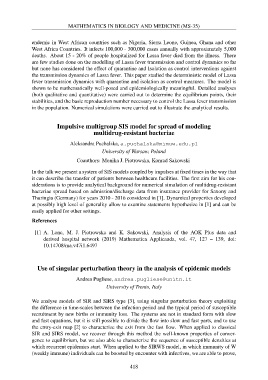Page 420 - 8th European Congress of Mathematics ∙ 20-26 June 2021 ∙ Portorož, Slovenia ∙ Book of Abstracts
P. 420
MATHEMATICS IN BIOLOGY AND MEDICINE (MS-35)
endemic in West African countries such as Nigeria, Sierra Leone, Guinea, Ghana and other
West Africa Countries. It infects 100,000 - 300,000 cases annually with approximately 5,000
deaths. About 15 - 20% of people hospitalized for Lassa fever died from the illness. There
are few studies done on the modelling of Lassa fever transmission and control dynamics so far
but none has considered the effect of quarantine and Isolation as control interventions against
the transmission dynamics of Lassa fever. This paper studied the deterministic model of Lassa
fever transmission dynamics with quarantine and isolation as control measures. The model is
shown to be mathematically well-posed and epidemiologically meaningful. Detailed analyses
(both qualitative and quantitative) were carried out to determine the equilibrium points, their
stabilities, and the basic reproduction number necessary to control the Lassa fever transmission
in the population. Numerical simulations were carried out to illustrate the analytical results.
Impulsive multigroup SIS model for spread of modeling
multidrug-resistant bacteriae
Aleksandra Puchalska, a.puchalska@mimuw.edu.pl
University of Warsaw, Poland
Coauthors: Monika J. Piotrowska, Konrad Sakowski
In the talk we present a system of SIS models coupled by impulses at fixed times in the way that
it can describe the transfer of patients between healthcare facilities. The first aim for his con-
siderations is to provide analytical background for numerical simulation of multidrug-resistant
bacteriae spread based on admission/discharge data from insurance provider for Saxony and
Thuringia (Germany) for years 2010 - 2016 considered in [1]. Dynamical properties developed
at possibly high level of generality allow to examine statements hypothesize in [1] and can be
easily applied for other settings.
References
[1] A. Lonc, M. J. Piotrowska and K. Sakowski, Analysis of the AOK Plus data and
derived hospital network (2019) Mathematica Applicanda, vol. 47, 127 – 139, doi:
10.14708/ma.v47i1.6497
Use of singular perturbation theory in the analysis of epidemic models
Andrea Pugliese, andrea.pugliese@unitn.it
University of Trento, Italy
We analyse models of SIR and SIRS type [3], using singular perturbation theory exploiting
the difference in time-scales between the infection period and the typical period of susceptible
recruitment by new births or immunity loss. The systems are not in standard form with slow
and fast equations, but it is still possible to divide the flow into slow and fast parts, and to use
the entry-exit map [2] to characterize the exit from the fast flow. When applied to classical
SIR and SIRS model, we recover through this method the well-known properties of conver-
gence to equilibrium, but we also able to characterize the sequence of susceptible densities at
which recurrent epidemics start. When applied to the SIRWS model, in which immunity of W
(weakly immune) individuals can be boosted by encounter with infectives, we are able to prove,
418
endemic in West African countries such as Nigeria, Sierra Leone, Guinea, Ghana and other
West Africa Countries. It infects 100,000 - 300,000 cases annually with approximately 5,000
deaths. About 15 - 20% of people hospitalized for Lassa fever died from the illness. There
are few studies done on the modelling of Lassa fever transmission and control dynamics so far
but none has considered the effect of quarantine and Isolation as control interventions against
the transmission dynamics of Lassa fever. This paper studied the deterministic model of Lassa
fever transmission dynamics with quarantine and isolation as control measures. The model is
shown to be mathematically well-posed and epidemiologically meaningful. Detailed analyses
(both qualitative and quantitative) were carried out to determine the equilibrium points, their
stabilities, and the basic reproduction number necessary to control the Lassa fever transmission
in the population. Numerical simulations were carried out to illustrate the analytical results.
Impulsive multigroup SIS model for spread of modeling
multidrug-resistant bacteriae
Aleksandra Puchalska, a.puchalska@mimuw.edu.pl
University of Warsaw, Poland
Coauthors: Monika J. Piotrowska, Konrad Sakowski
In the talk we present a system of SIS models coupled by impulses at fixed times in the way that
it can describe the transfer of patients between healthcare facilities. The first aim for his con-
siderations is to provide analytical background for numerical simulation of multidrug-resistant
bacteriae spread based on admission/discharge data from insurance provider for Saxony and
Thuringia (Germany) for years 2010 - 2016 considered in [1]. Dynamical properties developed
at possibly high level of generality allow to examine statements hypothesize in [1] and can be
easily applied for other settings.
References
[1] A. Lonc, M. J. Piotrowska and K. Sakowski, Analysis of the AOK Plus data and
derived hospital network (2019) Mathematica Applicanda, vol. 47, 127 – 139, doi:
10.14708/ma.v47i1.6497
Use of singular perturbation theory in the analysis of epidemic models
Andrea Pugliese, andrea.pugliese@unitn.it
University of Trento, Italy
We analyse models of SIR and SIRS type [3], using singular perturbation theory exploiting
the difference in time-scales between the infection period and the typical period of susceptible
recruitment by new births or immunity loss. The systems are not in standard form with slow
and fast equations, but it is still possible to divide the flow into slow and fast parts, and to use
the entry-exit map [2] to characterize the exit from the fast flow. When applied to classical
SIR and SIRS model, we recover through this method the well-known properties of conver-
gence to equilibrium, but we also able to characterize the sequence of susceptible densities at
which recurrent epidemics start. When applied to the SIRWS model, in which immunity of W
(weakly immune) individuals can be boosted by encounter with infectives, we are able to prove,
418


